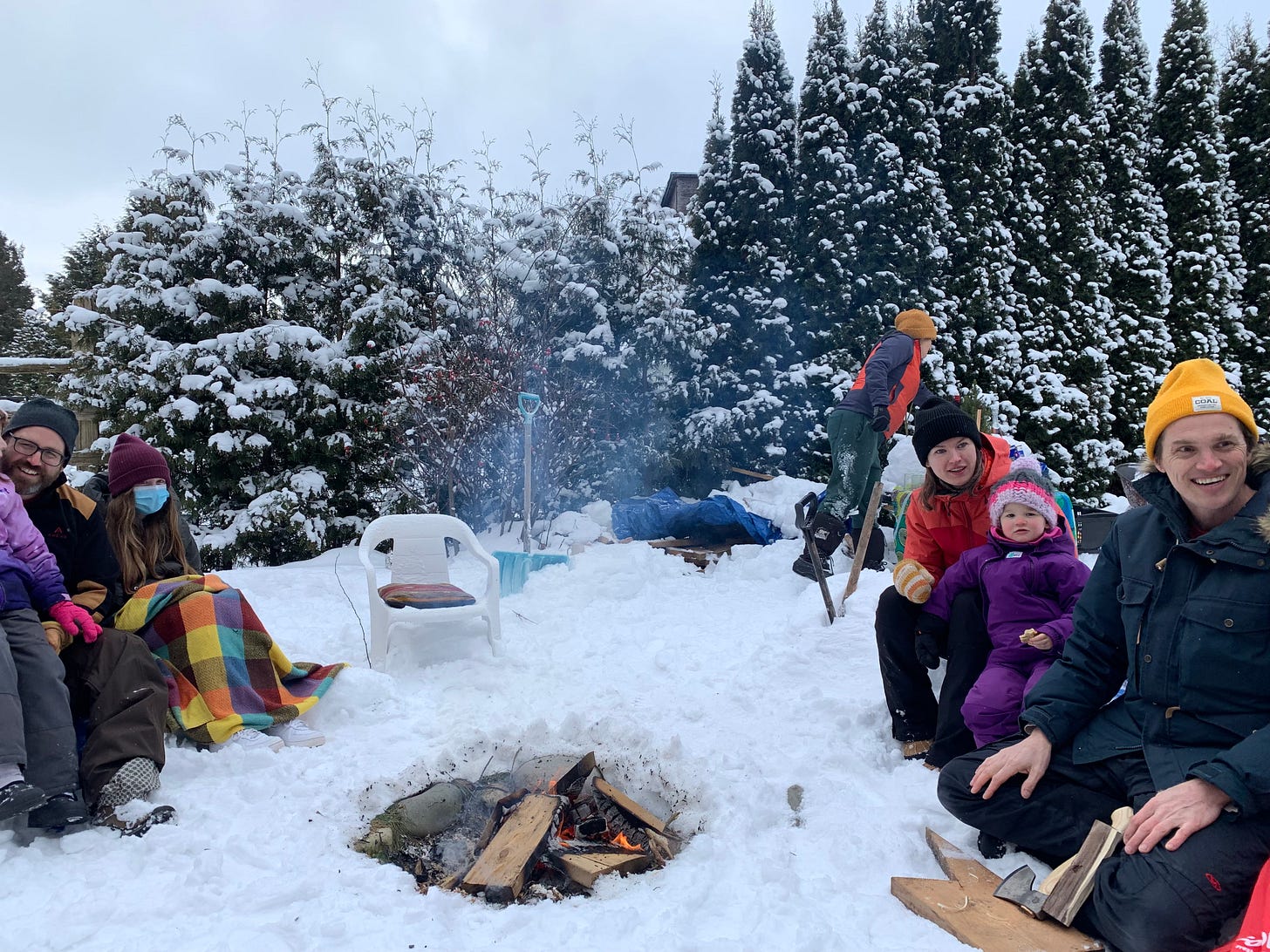How to Encourage Independent Play
A lengthy list of practical ideas for getting kids to play on their own
One of my posts from last week, titled “I Don’t Play With My Kids,” hit a nerve with readers. It is the most-commented-on article I’ve written for The Analog Family to date, which shows that parents have a lot to say about getting kids to play independently, without adult involvement.
I noticed that a number of commenters were parents of single children asking for guidance on how to keep their kids occupied without siblings. I received the same question earlier this summer, from a reader in Germany, who emailed me to say, “In your posts and in your book, you very often mention how your boys take advantage of each other's company. However, how do you deal with some situations if you only have one child, particularly if he really does not ever play alone?”
So, today, I’d like to dig deeper into this question of kids amusing themselves and how a parent can facilitate it, practically and realistically. One caveat: I have three children, so I cannot speak from the experience of raising a single child, apart from the initial two years of my first child’s life (which did teach me a lot). But I do think these ideas are universally applicable, regardless of how many kids live in your home.
Get out of the way.
One commenter named Ginny put it beautifully. When you see independent play happening, you should “make yourself invisible and give a wide berth.” This is so true. A child who’s getting into an imaginary play zone should not be interrupted by an overenthusiastic parent. Quietly tiptoe away. Do not acknowledge how thrilled you are that they’re playing independently, or you risk shattering the moment.
This is aligned with my message in a post titled “Subtract Yourself,” where I urge parents to step back so kids have room to grow. Realize that solo play is a learned skill that must be practiced over and over again. Don’t be frustrated if it doesn’t happen right away; give it time and patience, and it will happen.
Is your home interesting to a child?
If you visited my home, you wouldn’t see many stereotypical toys. Many toys are quite boring because they have a single purpose, and there are only so many times you can repeat that action. Instead, ask yourself if you’d want to play in a particular space for hours on end.
The key to ongoing stimulation is sometimes called “loose-part toys”, which are toys with open-ended purposes, whose uses can be reinterpreted based on the child’s age, their mood, who their playmates are, what the season is, etc. Building materials are always great. We’ve always got a supply of cardboard and wood in the garage, with hammers, nails, and handsaws. There are shovels and rakes for the dirt pile, water sources (hose and outdoor shower), buckets, a fire pit with a heap of sticks. “Mud kitchens” are a classic source of entertainment. Inside, we have board games, art supplies, lots of books, Lego, and more.
You don’t need a lot of room. Remember that, to a child, a tiny backyard can feel like a magical kingdom, given the right mix of play materials and nature. Until the age of 6, I lived in a 400-square-foot cabin, and it felt huge to me. Now when I see it, I’m stunned at how cramped it must have been—but I never felt that way as a child.
I’ve written about this idea in Buy Real Toys and Designing for Offline Play.
Can your child move physically?
Kids are extremely active little humans. I think they’re often not given enough opportunities to burn off energy, and so we adults need to create them. That’s why my second-hand trampoline purchase was one of the best things I’ve ever bought—same with the slack line in our front yard. My kids use these for hours on end. We had an old hammock on the porch that they used as a pirate ship, for cocooning each other, for spinning wildly, and for lounging with comic books until it finally tore apart this summer. We have pogo sticks, skateboards, scooters, skipping ropes, and skim boards for the beach.
Involve the child in your work.
A great line from Hunt, Gather, Parent by Michaeleen Doucleff:
“When a child breaks rules, acts demanding, or seems ‘willful’, their parents need to put them to work. The child is saying, ‘Hey, Mom, I’m underemployed over here and it doesn’t feel good.”
Since reading that book, I’ve started pulling my kids into cooking and cleaning jobs more persistently. They’re surprisingly adept at helping, and it gives them a sense of purpose while teaching them valuable skills. It helps to pass the time, too.
Offer the option of work or play.
Moving into more of a pressure tactic, this is something I’ll sometimes do when my kids are struggling to entertain themselves independently. Let’s say I’m preparing food and they’re standing around the kitchen, feeling aimless. I’ll tell them, “You can unload this dishwasher and peel this pile of potatoes, or you can go outside to play without coming back inside for 30 minutes.” Nine times out of 10, they choose the latter—and it gives me the much-needed break I secretly wanted.
Note: I don’t do this frequently, as I don’t want housework to be framed as a punishment or as something they can opt out of in favour of play on a regular basis. I’ve just found that the threat of something “worse” can be an effective catalyst to incentivize free play when that’s why I want them to do.
Can you “import” other kids?
If you have just one child, or two siblings who aren’t getting along, is there a way to bring more kids into your home to add variety to their play and relationships? Do you have nephews or nieces or close friends whose children could come stay with you for a prolonged period of time? If you only have one kid, could you invite a couple neighbour siblings over to play, or hire an older kid to play now and then?
When I was a kid, my three cousins, my sister, and I would spend a week each summer at my aunt’s farm in the Niagara region, followed by a week at my house in Muskoka. It was an ideal swap for our mothers, who probably worried about us less when there were five little girls playing together, and then got a whole week off.
What about a regular kid swap schedule?
Another anecdote: When my first child was a year old, I met a woman with a baby the same age. Both of us were finishing university degrees that year, and both of us needed childcare. So, we agreed to do a straight childcare exchange. One day per week, I watched her child, and then she took mine for another day. Those were full days, 8 am till 5 pm. This meant that we spent zero dollars; we each incorporated another child into our regular routine, which required little additional work; and each of our only children essentially gained a sibling for 2 days out of each week. Fifteen years later, our boys are still best friends.
You could do something similar with after-school care, connecting with another family (or two or three) who is willing to take turns doing pickup, snacks, and general supervision.
Build multi-age playgroups (MAPs).
It’s important for kids to play with other children from different age groups, as this is how they learn new skills and strive to model more advanced behaviours. Another good idea from Doucleff’s book:
“You can keep it simple and encourage kids in your neighborhood to play together after school and weekends. I often tell [my daughter], ‘Go get Marat [the boy who lives next door],’ which I alternate with ‘Go play at Marat’s house.’ Or you can organize a weekly neighborhood playgroup in your backyard or a nearby park. Invite all the kids in the neighborhood to come for a few hours on a Saturday or Sunday. One or two other parents are all you need… Ideally, parents would disappear into the background and interfere only if a child is going to get hurt.”
See my posts: Seventeen Seconds and Be a Lifeguard Parent.
Use a timer.
I love timers. I use them constantly for parenting, whether it’s for timing how long one of my kids has to practice their music instrument each day (yes, they hate it) or gets to hold the hamster or play with a particular toy. I have also used timers to designate chunks of time for independent play.
Especially when my kids were younger, I’d say, “I’m setting a timer for 30 minutes. You need to find something to do on your own, and then after, we can be together again.” Sometimes this is essential for carving out solo time or getting basic chores done.
As they got older, I put it on them. “Please set your watch timer for 45 minutes. Go outside. When it beeps, you may come back in.” This gave them a sense of ownership and responsibility, and they wouldn’t keep asking me when it was time to come back in.
On occasion, when I was really desperate for a break, I’d add a consequence for disruption: “If you ask me how much time is left, I’ll add 5 minutes to the timer.”
Inevitably, they would find games to play—and often when the timer was up, they wouldn’t want to come back inside.
You can be present without participating.
I will often head outside when my kids are out there, but I’ll read a book and drink tea while they play. I’ve noticed they are more inclined to be out there if I’m there, too—but it doesn’t mean we have to play together. Sometimes I say, “This is how I play! This is my idea of playing, and you’re welcome to join me with your own book and a mug of tea.” Occasionally they do, but more often they head off to invent a game.
Deschedule your family’s life.
The more downtime a child has to entertain themselves, the more accustomed they’ll become to it, and the easier it will get. By contrast, if there’s only a single night each week when they don’t have extracurricular activities, don’t be surprised if they seem aimless and discombobulated. They’re not used to it.
Can you get a pet?
Our hamster has become such a huge part of my kids’ entertainment, it’s astonishing. I never thought the novelty would last, but it has. We are on our third hamster, and they’re convinced she’s the “smartest one yet.” They build her mazes out of cardboard and wood, take her outside to play in the grass, try to teach her tricks, and more. Getting a pet might be key to helping children, particularly singles, feel like they always have a playmate.
Establish places for your child to go independently.
We have a list of familiar trail loops for walking and biking that we can reference and suggest as places for our kids to go if they need to get out of the house. Because we’ve done them so many times as a family, they’re comfortable doing them alone. Same goes for public gathering places that we’ve visited and discussed ahead of time, such as the library, skate park, break wall at the lake, soccer park, skating rink, and more. It’s sort of like having a list of “boredom busters” at your disposal—things a kid can do if they’re craving some stimulation.
I’d love to hear more ideas from readers, so feel free to share thoughts in the comments below.
You Might Also Like:
A Small Reminder:
I am able to write this newsletter twice a week, thanks to generous readers who enjoy my words enough to sign up for a paid subscription! Substack is not exactly a money-maker, if I’m honest, but every bit helps—perhaps most of all by validating my belief that I’m on the right track with this quest to reclaim childhood from digital devices. Thank you for your support.







One trick I've found helpful for establishing independent play when they are little is sometimes offering music or an audiobook in the background. My almost 3 year old plays independently pretty well, but when she was starting out or now on days when it's a harder transition for her, the sound almost seemed to help her detach from me and not be as distracted by me as I went in and out of the room with my tasks.
I don't want to overstimulate her or constantly have noise in our home, but I do love having music as I go about my tasks, and she does too.
Great ideas! I am an artist, so I always have art supplies on hands. Even in our family room, I still keep pens, and adult coloring books for my older children. It works, they love it, and even when I have friends come over they’ll pick it up and just play around with them. I believe that what your children are surrounded with and the more time they have to be “bored” the more creativity and independence they will show!!